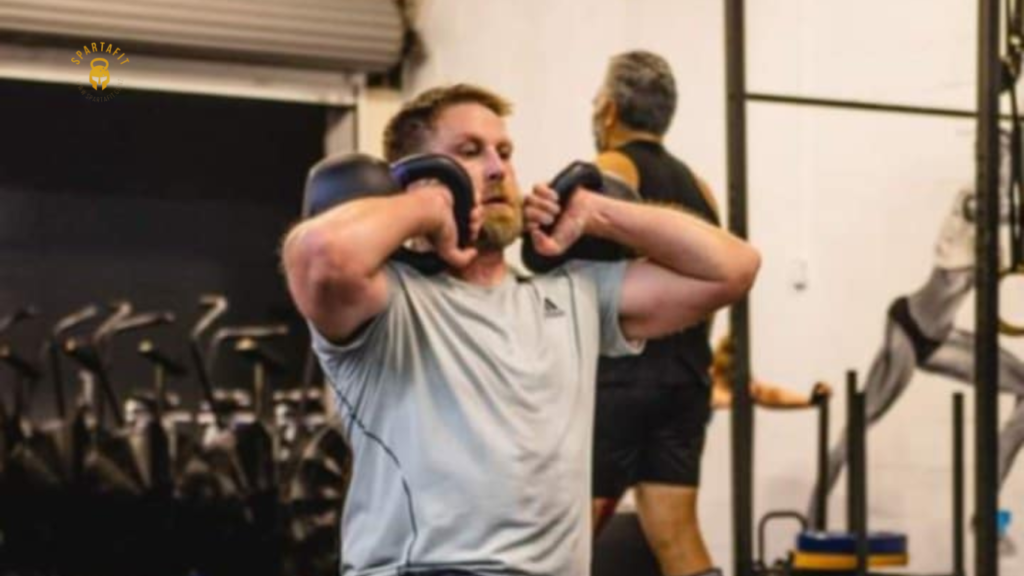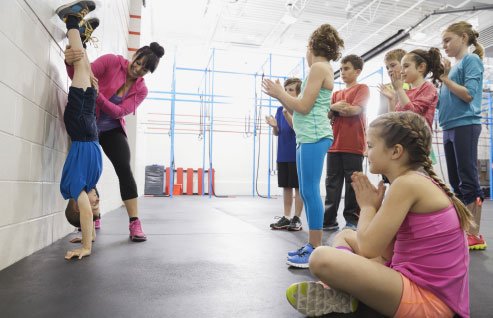Share with your friends!
Frequently Asked Questions If there are any questions not answered below or just want to know more, drop us an email, text or call.
Functional fitness is a type of exercise that trains muscles used in daily
activities. It aims to improve strength, flexibility, and mobility.
Functional fitness can improve coordination, flexibility, and cardio fitness. It can also help with weight management and spine health. Makes everyday activities easier. Because the focus is to train the muscles that you use in daily life, which helps reduce your risk of injury or fatigue.
Yes you will ! This is a big part of Sparta training. Our class programming is in 8
week blocks and it covers progressions or skills development. After each block,
members are getting fitter and picking up skills along the way.
A typical workout changes daily but at its core, it has four elements: a warm up,
strength work, technique work, the daily workout, and stretching or cool down.
Each workout is scalable so everyone can join in, despite their fitness level.
By training regularly. We recommend 3 classes a week minimum for optimum
results.
A welcoming environment! and a challenging yet achievable workout.
If you are really real to it all or coming back, expect an introduction to basic
movements which is our Sparta Intro complimentary service.
Yes we do!. Coach Luke is not only an experienced Coach and Chiropractor. But qualified to give nutrition consultation.
We have bathrooms with toilets, a shower, bag storage in a members
area. We also in 2025 are going to expand on these with renovation plans.
Yes we do! It’s the recommended first step. The journey starts by trying it first. Click here for your trial
FAQ| Kids & Teens Fitness Classes
SPARTAKIDS is a progressive coach led kids gym program offering classes in the following age groups: Kids – 5 to 9yrs, Juniors – 10 to 13yrs and Teens – 14 to 18yrs. Following this, teenagers matriculate into adult SPARTAKIDS classes. The class structure across the age groups is generally the same. Classes include a warmup, skill drills and workout and exercise intensive games. For Juniors and Teens we’d encourage post workout study as research has found there is an optimal learning capacity of the brain for 20-40 minutes after exercise.
The SPARTAKIDS fitness program combines gymnastics, bodyweight calisthenics and weightlifting elements to develop capacity across ten general physical skills: cardio-respiratory endurance, power, strength, stamina, speed, agility, flexibility, balance, accuracy, and co-ordination. Additional elements that encourage bone density development, cross body movements and exercises that involve the vestibular system are also incorporated.
Children and teens have a greater opportunity (relative to adults) to maximise their physical skills when exposed to this stimulus during years of peak development. The elements are combined to keep children engaged and entertained, while teaching them proper movement technique and creating a broad athletic foundation. Nutrition is also discussed as the basis of athletic performance and health within a supportive community.
Coaches will determine and discuss with parents when children are ready to move from one program level to the next. This will differ for each child; the age recommendations for each program are just that. When a child is ready to move onto the next class, graduation will be awarded and the coach will advise the parents. There are three primary elements that are evaluated: physical capacity, behavioural ability/control, and safety. Many children excel in one area but not in another. Graduation is at our discretion and we attempt to place all children in the appropriate class.
In some cases a child’s needs may not be met by the class environment, in which case the assessing coach will advise private training as an option.
SPARTAKIDS focuses on a child’s motor and cognitive skills by teaching proper movement in an interactive and fun group setting through challenging the children to think about their movement, count their repetitions, remember sequences and work towards goals. SPARTAKIDS supplements a child or teen’s involvement in sports by incorporating strength training and conditioning to make our participants better athletes at any sport or play.
One of the hallmarks of SPARTAKIDS is inclusion. Training in a group of peers can have a profound positive effect, increasing daily compliance with the program, pushing mental and physical limits, and maintaining a positive sense of self (Beets et al. and Vorhees et al.). Children that are deconditioned will also benefit from exercising in a group. The key to incorporating children with various physical abilities is in modulating the planned workout, often referred to as scaling, to accommodate differing abilities and capacities. The immediate goal is inclusion and maintenance of the general movement patterns, the long-term goal is to have each individual continue to improve and require a decreasing amount of scaling.
Beets MW et al. Social support and youth physical activity: The role of provider and type.American Journal of Health Behavior 30(3): 278-289, May 2006. http://www.ncbi.nlm.nih.gov/pubmed/16712442
Vorhees CC et al. The role of peer social network factors and physical activity in adolescent girls. American Journal of Health Behavior 29(2): 183-190, 2005. http://www.ncbi.nlm.nih.gov/pubmed/15698985
We receive questions regarding safety and weightlifting for children. Weightlifting is both safe and beneficial for children when properly supervised. The following may provide more insight and helpful information into the topics of organised fitness activities and training of young athletes.
Proper Training Age
“At what age should my child start participating in an organized training program or kids gym?”
Human muscle innervation is completed around 6–7 years of age (Grasso 2005). This implies that the brain has formed its neural connections to the muscular system and that optimization of these connections can begin. This makes it more possible to perform coordinated activities. By 10–12 years of age, reflexive motor patterns are conditioned and relatively permanent (Grasso 2005). These findings suggest that introducing proper motor skills between the age of muscle innervation and the age of permanent motor pattern formation may be advantageous (Drabik 1996).
Research has demonstrated that children as young as 5 have experienced benefits from organized programs, such as resistance training (Annesi et al. 2005). However, while the neuromuscular system may be ready to acquire skill at a young age, starting on an organized regimen requires an adequate level of mental, physical and emotional maturity (Ashmore 2003; Drabik 1996; Grasso 2005). Regardless of age, the child must be able to focus, follow directions, understand coaching cues and be physically proficient enough to accomplish movements in response to cues. The criteria for beginning a program, therefore, have more to do with these characteristics than with exact chronological age (Grasso 2005). A physically and mentally capable youngster benefits from a well-designed program that increases motor coordination, strength, aerobic capacity, flexibility, bone health and a variety of other physical traits (Faigenbaum et al. 2009). Additionally, the child develops exercise habits that will mold his/her lifestyle for years to come.
It is essential that an organized training program for a child is safe, developmentally appropriate and engaging; it must offer the child an all-round positive experience. Much of the hesitation that parents feel is due to tales of inexperienced, overzealous coaches who implement unsafe poorly designed programs—particularly in resistance training. During the 1970s and 1980s, data from the National Electronic Injury Surveillance System suggested that resistance training was a dangerous activity for youth, given the numerous emergency-room reports of injuries from exercises and equipment. When the data were revisited, however, researchers concluded that nearly all of the injuries resulted from improper training techniques, excessive loading, lack of adult supervision or faulty equipment (Faigenbaum et al. 2009). Current research has not discovered any overt clinical injuries during properly designed and supervised resistance training at any age (Faigenbaum et al. 2009).
Children of any age can benefit from organized training as long as they have the physical, mental and emotional maturity to address the demands of an appropriate, well-designed program in a positive, engaging environment.
The SPARTAFIT Coaching staff have years of experience in the field of fitness and human performance. We invite you to review our expertise and educational credentials.
Training Type
“What type of training should a particular athlete do?”
Parents often want to improve a child’s physical characteristics as they apply to a particular sport. When you consider the wide array of physical capabilities—strength, balance, coordination, power, visual perception, etc. that combine to create athleticism, sport specific training for youth is a ridiculous notion. A recent study by the American Academy of Pediatrics (AAP) found that young people who participated in a variety of sports and other activities prior to puberty were more consistent performers, had fewer injuries and had longer athletic careers (AAP 2001). Regardless of the sport a youngster chooses to play, he/she will need to be proficient in all of the capabilities mentioned above in order to advance his/her level of play and learn positive exercise habits that last a lifetime.
Parents often confuse sport skills and general physical preparation. Every sport has a specific set of tactical skills. In soccer, for example, you must be able to dribble, pass, trap the ball and shoot. These are specific skills related to the game of soccer. These skills, however, are made up of more general physical capabilities, such as strength, coordination, balance, mobility, etc., that aid in creating overall athleticism. Even this wide range of general physical capabilities can be broken down into primary physical attributes, such as rhythm, kinesthetic differentiation, body awareness, movement adequacy and others (Drabik 1996; Grasso 2005). If you focus your training primarily on a specific skill set, you ignore the important foundations of that skill set.
The less experienced a child is with physical movement, the wider the range of physical abilities you must address. As the child becomes proficient in basic abilities, you can introduce more specific skill sets. For example, a young or physically inexperienced client should begin with movements that require very general physical abilities. Good choices include exercises and games that require skipping, marching, hopping, grasping, crawling, climbing, rolling, catching, throwing and kicking (Drabik 1996; Grasso 2005). When the child can accomplish these tasks well, move on to more specific preparatory activities, such as running, resistance training exercises (beginning with body weight), sustained cardiovascular exercise and other related athletic drills.
Author: Brett Klika (IDEA Author and Presenter) is the director of athletic performance at Fitness Quest 10 in San Diego, California. He specializes in youth fitness and athletic performance. Brett oversees a staff of eight strength coaches and develops program for over 300 youth athletes (and non-athletes) per week. He is a regular contributor for a variety of publications, produces DVDs on fitness and athletic performance and presents around the world.
Kids may attend as often as they can and want. If your child has a sport practice schedule, speak with a SPARTAFIT coach to evaluate and plan the inclusion of SPARTAKIDS. We have coached many kids who are reps of multiple sports while also attending SPARTAKIDS classes. We recommend training can be maintained even during sport season; discuss a maintenance schedule with our Head Coach.



